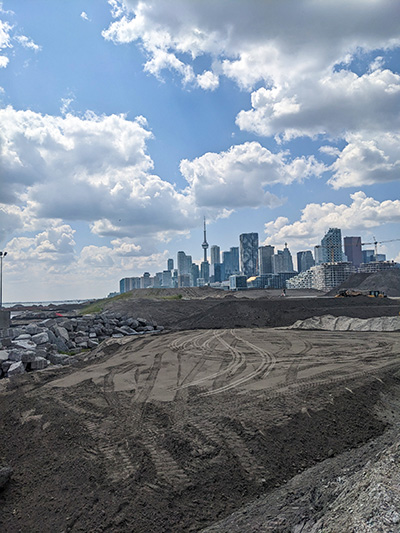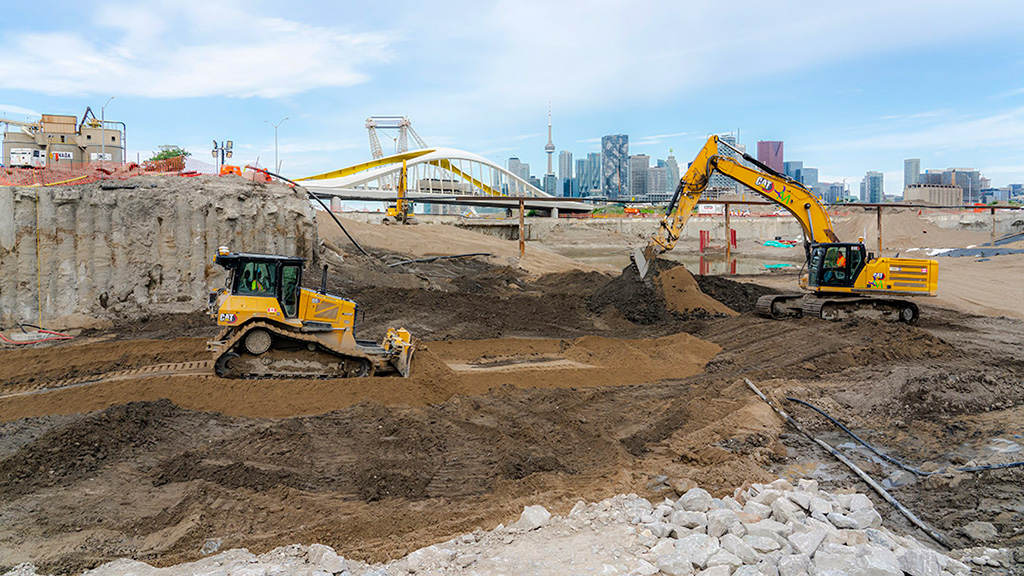This is the second in a two-part series on a massive project taking place in the Port Lands area of Toronto. This article focuses on novel construction work being done to create a new mouth for the Don River.
Construction crews are in the process of creating a new mouth for the Don River in Toronto where it flows into Lake Ontario.
The project is part of the $1.25-billion Port Lands Flood Protection Project (PLFPP), a series of improvements and infrastructure work aimed at protecting swaths of land in the city’s southeastern downtown during extreme weather when floodwaters from the winding watercourse can overflow its banks.
The project will create a new mouth for the river in the middle of the Port Lands between the Ship Channel and Keating Channel, as well as the foundations of a new urban island neighbourhood called Villiers Island.
There is still plenty of work to do but Waterfront Toronto is confident the project will be completed by the end of 2024.
Don Forbes, project director, soil remediation and earthworks at Waterfront Toronto, says the PLFPP project is going well and some important milestones have already been celebrated, such as the partial opening on the new Cherry Street alignment last fall, and the arrival and installation of four new bridges.
Re-engineering and re-naturalizing the mouth of the Don River is a complex project but, when completed, will protect hectares of land from flood risks.
“The project will also deliver a substantial return on investment by helping set the stage for and facilitate future residential and commercial development in the Port Lands,” says Forbes.
Creating a new mouth for a still-flowing river is a complex project that has many moving parts.
Cut-off walls, consisting of mostly secant pile wall, had to be installed to separate the existing Don River from the new river valley. To build the wall, a series of holes were drilled into the bedrock and filed with concrete to create piles.
Piles were drilled next to each other and overlapping to create the structure.
The walls extend up to three metres into the bedrock to support excavation sidewalls, allow for continuous dewatering of the river valley during construction, and prevent groundwater from entering the river valley.
Much of the soil in the river valley was geotechnically unsuitable and contaminated and was remediated for use elsewhere on the site.

A system of drains and pipes has been installed to draw down the groundwater and ensure the excavation remains dry during construction of the river finishes.
Crews installed a special liner to act as a barrier between the remaining soil and the newly constructed river valley.
Then, the base of the river, including river bottom materials, clay levy cores and riverbanks were built on top of the liner.
The river itself will be, on average, approximately two to three metres deep.
A number of plug walls, meanwhile, were installed as part of the cutoff walls that ring the entire river valley to keep water from flowing in from other watercourses.
“All of the walls, plus the bedrock, form something like a giant underground bathtub, except that they keep the water outside of the bathtub,” explains Forbes.
When the river valley is complete, the cut off walls will be removed, along with the plug walls at different times, to allow the water to flow.
“As we inundate the river by pumping in water from the lake, the bathtub will still be in place,” notes Forbes. “Once the water level in the river is roughly the same as the lake level, we’ll remove the portions of the wall that align with the existing Don River channel and the new mouth at Lake Ontario to allow the water to flow.”
The first plug to be removed will allow water from the Ship Channel to flow in an out of the Don Greenway. A second plug connecting the new river with the Polson Slip and Lake Ontario, will be removed next, and a third plug which connects the new river valley with the existing Don River will be the last to be removed.
Crews are still excavating some remaining sections of the river valley near the plugs. Current work is focused in an area that was under the old alignment of Cherry Street between Commissioners and Polson streets.
Work also continues to install the river liner and underdrain, and crews are doing below-grade earthworks and utilities installation in surrounding parks.
EllisDon is construction manager on the project. Various subcontractors working on the project include those in trades related to excavation, earth boring, demolition, soil remediation, environmental monitoring, planting, landscaping, utilities, and road and bridge construction.
Engineers working on the project designed the new river valley to mimic a natural watercourse as much as possible. However, a natural river meanders over time and engineers had to take that into account.
Forbes says they “bio-engineered” riverbanks that use a crib-wall system to create meanders but also stabilize the location of the river so that it doesn’t change its route.
“This is a system of logs with their roots still attached that are buried with the roots exposed to the river. The structure is very resistant to erosion and has the added benefit of providing high-quality aquatic habitat.”
1.25B Port Lands flood protection one of the biggest projects in Toronto’s history



Recent Comments